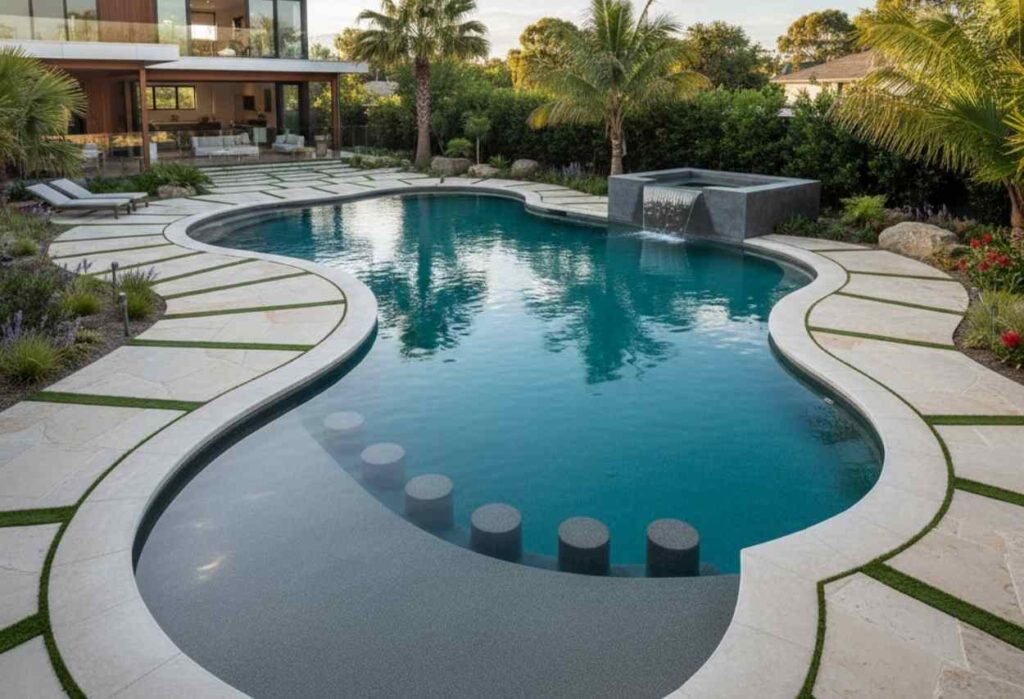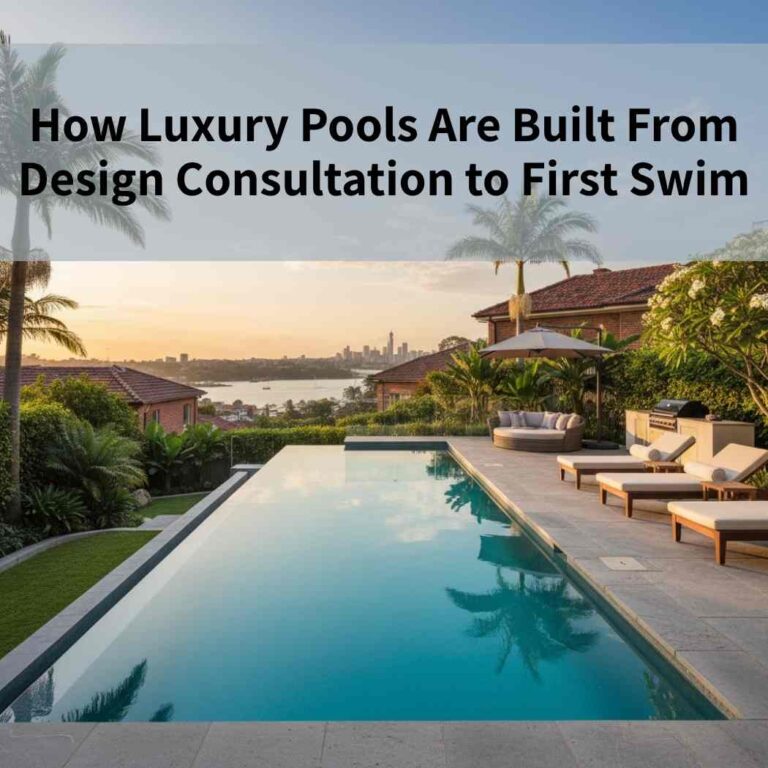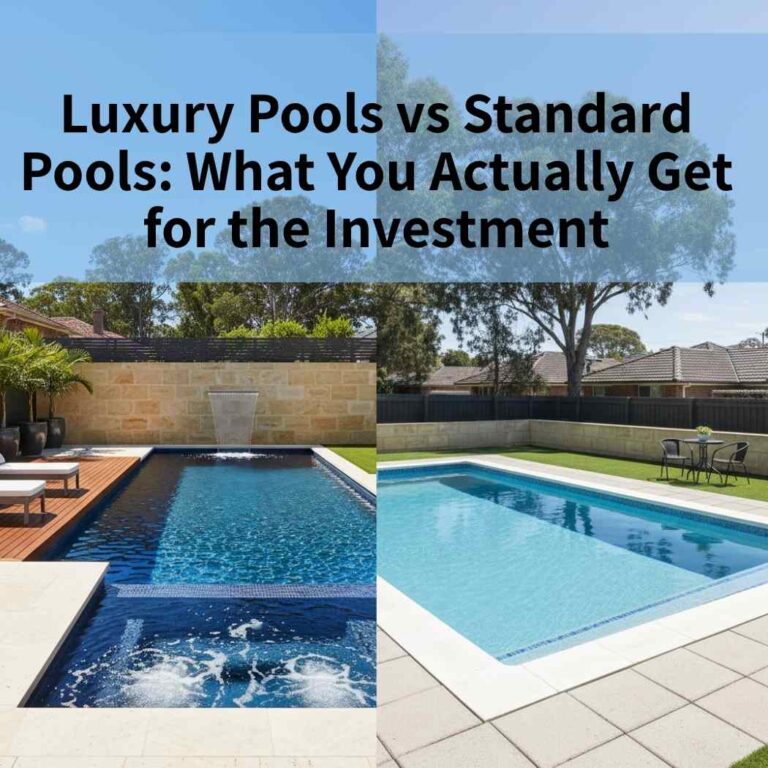At Plunge Pools Sydney, the team specialises in hydraulic design and efficient water systems for large pool builds. Their experts focus on cost-smart planning, using proven methods to balance design, function, and long-term savings. From pump sizing to filtration layouts, every part of the pool installation process is handled with care to make sure you stay on budget.
In this article, you’ll learn where budgets often go wrong, how hydraulic systems protect your investment, and how smart planning can prevent costly surprises during your Sydney pool project.
Table of Contents
ToggleUnderstanding Where Budgets Go Wrong in Large Concrete Pool Projects

Budgets for large concrete pool projects often fail when key planning steps are skipped before building begins. Many Sydney homeowners face surprise costs due to soil issues, design changes, or plumbing problems that require rework. The main cause is underestimating the complexity of a pool’s hydraulic and drainage syste
Every large ground pool depends on water flow, filtration, and drainage systems. If these parts aren’t planned properly, costs rise during construction and throughout the pool’s life. A strong design keeps water moving, prevents waste, and avoids long-term damage to the pool.
Why Water Management Systems Define Long-Term Value
Water management systems define long-term value because they control how water moves, filters, and recycles through your custom-designed pool. When they’re designed well, they lower maintenance costs, reduce leaks, and improve efficiency.
Sydney’s warm climate brings higher evaporation rates and strict water restrictions. A well-built system helps your outdoor space meet local standards and stay affordable to maintain.
How Does Hydraulic Design Improve Cost Efficiency?
Hydraulic design improves cost efficiency by making water flow through your pool system with minimal energy use. It calculates the right pipe sizes, pump speeds, and flow rates for smooth and steady operation.
At Plunge Pools Sydney, engineers use flow modelling software to create innovative pool solutions that save power, reduce wear on pumps, and lower long-term maintenance costs.
What Hidden Costs Should You Watch Out For?
You can avoid hidden costs by testing soil early, planning your hydraulics properly, and balancing design with function. Many Sydney projects face surprise expenses from poor drainage, missing hydraulic plans, or forgotten access points.
Underestimating Soil and Drainage Conditions
Soil and drainage problems can add thousands to your project. Sydney’s mixed soil types can cause movement or cracks if not tested early. A professional soil test and drainage plan prevent costly repairs later.
Ignoring Hydraulic Design During Planning
Skipping hydraulic design leads to higher power bills and frequent maintenance. Getting a hydraulic engineer involved early ensures efficient flow and balanced pressure across your system.
Choosing Aesthetic Over Functionality
Luxury features like infinity edges or lighting look great but can affect water circulation. Always plan these features with hydraulic design to keep your custom pool both attractive and efficient.
Failing to Budget for Maintenance Access
Maintenance access should be included in your design from the start. Without proper access, technicians struggle to reach pumps and filters, increasing labour costs later.
Hidden Financial Risks in Sydney’s Compliance and Weather Conditions
Sydney’s pool regulations and weather conditions can raise your total project cost if not planned for early. Delays from council permits, stormwater rules, or site inspections can add time and money.
Heavy rainfall can delay excavation, while unstable soil increases the risk of cracking. Working with an experienced pool professional who understands Sydney’s codes helps avoid these risks and keep your budget on track.
Smart Water Management = Smart Budgeting
Smart water management helps you save money by lowering energy use and reducing water waste. Modern systems include automation, leak detection, and recycling features that keep your new pool efficient year-round.
At Plunge Pools Sydney, each system is designed with sustainability and long-term value in mind, helping homeowners save thousands over the life of their pool ownership.
Traditional vs Water-Managed Pool Designs: Budget Impact
Water-managed pool designs cost less to run and maintain compared to traditional systems. They use smaller pumps, balanced flow, and efficient filtration that save energy and water.
Here’s a simple comparison:
Traditional Concrete Pool – Higher upfront and running costs, frequent maintenance, and higher water use.
Hydraulically Managed Pool – Balanced upfront cost, lower electricity bills, and efficient water circulation that saves thousands over time.
What We Often See in Sydney When Building Large Concrete Pools
In Sydney, budget issues often appear when hydraulic design is left too late. One homeowner spent $15,000 extra fixing filtration problems, while another saved $20,000 through early flow modelling and soil testing.
Planning for drainage, slope, and soil conditions before excavation keeps project costs predictable and avoids expensive mid-build changes. A professional concrete pool builder ensures each design and build stage runs smoothly from start to finish.
How to Plan Your Budget the Right Way
Planning your pool budget the right way means knowing your costs before work starts. Get a hydraulic assessment early, choose efficient equipment, and keep 10–15% of your total budget for unexpected changes.
Typical Sydney pool cost ranges:
- Excavation and soil work: $10,000–$25,000
- Hydraulic system and equipment: $8,000–$15,000
- Finishing and landscaping: $20,000–$40,000
You can request a free Budget Planning Template from Plunge Pools Sydney to help map out your costs and turn your backyard into an oasis with a stunning pool area.
What Should You Look for in an Engineer or Contractor?
You should look for a licensed and skilled pool builder who provides clear cost breakdowns and warranty coverage. They should also show past projects and how they improved energy and water efficiency.
Asking about council compliance, drainage solutions, and ongoing service support ensures your pool remains safe and affordable long-term. The right company combines technical skill with a high level of expertise to deliver lasting value around the pool.
Conclusion
You can keep your large custom concrete pool on budget by starting with a strong hydraulic design and local expertise. Proper planning lowers running costs, prevents repairs, and makes your outdoor space last longer.
For expert advice and a free on-site water management assessment, contact Plunge Pools Sydney today. Build an oasis that’s beautiful, efficient, and built to last without the financial stress.
FAQs
How long does it typically take to complete a large concrete pool project in Sydney from design to handover?
A large concrete pool project usually takes 10–16 weeks from design to completion. Weather, council approvals, and site access can affect the schedule.
What are the most common mistakes homeowners make when budgeting for a concrete pool build?
Skipping hydraulic design, underestimating soil costs, and forgetting maintenance access are the biggest mistakes. Planning early avoids most of these issues.
How does Sydney’s weather affect pool construction costs?
Rain can delay excavation and add drainage expenses, while extreme heat affects concrete curing. Builders plan around these factors to stay on schedule.
Are there rebates for water-efficient pool systems in Sydney?
Yes. Some Sydney councils and NSW programs offer rebates for energy-efficient systems like variable-speed pumps and rainwater tanks. Check local council websites for details.
How much does it cost to build a large concrete pool in Sydney?
Large concrete pools in Sydney usually cost between $80,000 and $150,000. Site access, soil type, and finishes affect the total cost. Hydraulic planning keeps expenses stable.
What maintenance keeps costs low after installation?
Regular filter cleaning, water balancing, and pump servicing keep energy use low. Using automation and energy-efficient pumps helps reduce long-term bills.




